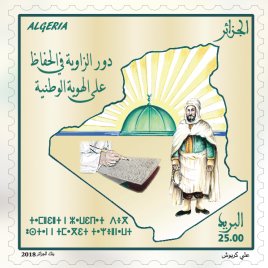Stamp: The Role of the Zawiya in Algerian History (Algeria 2018)
The Role of the Zawiya in Algerian History (Algeria 2018)
03 September (Algeria ) within release The Role of the Zawiya in Algerian History goes into circulation Stamp The Role of the Zawiya in Algerian History face value 25 Algerian dinar
| Stamp The Role of the Zawiya in Algerian History in catalogues | |
|---|---|
| Colnect codes: | Col: DZ 2018-17B |
Stamp is square format.
Also in the issue The Role of the Zawiya in Algerian History:
- Stamp - The Role of the Zawiya in Algerian History face value 25;
- Stamp - The Role of the Zawiya in Algerian History face value 25;
|
Data entry completed
46%
|
|
|---|---|
| Stamp The Role of the Zawiya in Algerian History in digits | |
| Country: | Algeria |
| Date: | 2018-09-03 |
| Emission: | Commemorative |
| Format: | Stamp |
| Face Value: | 25 Algerian dinar |
Stamp The Role of the Zawiya in Algerian History it reflects the thematic directions:
A map is a symbolic depiction emphasizing relationships between elements of some space, such as objects, regions, or themes. Many maps are static, fixed to paper or some other durable medium, while others are dynamic or interactive. Although most commonly used to depict geography, maps may represent any space, real or imagined, without regard to context or scale, such as in brain mapping, DNA mapping, or computer network topology mapping. The space being mapped may be two dimensional, such as the surface of the earth, three dimensional, such as the interior of the earth, or even more abstract spaces of any dimension, such as arise in modeling phenomena having many independent variables. Although the earliest maps known are of the heavens, geographic maps of territory have a very long tradition and exist from ancient times. The word "map" comes from the medieval Latin Mappa mundi, wherein mappa meant napkin or cloth and mundi the world. Thus, "map" became the shortened term referring to a two-dimensional representation of the surface of the world.
Religion is any cultural system of designated behaviors and practices, world views, texts, sanctified places, ethics, or organizations, that relate humanity to the supernatural or transcendental. Religions relate humanity to what anthropologist Clifford Geertz has referred to as a cosmic "order of existence". Different religions may or may not contain various elements ranging from the "divine", "sacred things", "faith", a "supernatural being or supernatural beings" or "some sort of ultimacy and transcendence that will provide norms and power for the rest of life". Religious practices may include rituals, sermons, commemoration or veneration (of deities), sacrifices, festivals, feasts, trances, initiations, funerary services, matrimonial services, meditation, prayer, music, art, dance, public service, or other aspects of human culture. Religions have sacred histories and narratives, which may be preserved in sacred scriptures, and symbols and holy places, that aim mostly to give a meaning to life. Religions may contain symbolic stories, which are sometimes said by followers to be true, that have the side purpose of explaining the origin of life, the Universe and other things. Traditionally, faith, in addition to reason, has been considered a source of religious beliefs. There are an estimated 10,000 distinct religions worldwide. About 84% of the world's population is affiliated with one of the five largest religions, namely Christianity, Islam, Hinduism, Buddhism or forms of folk religion.



